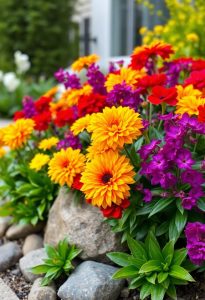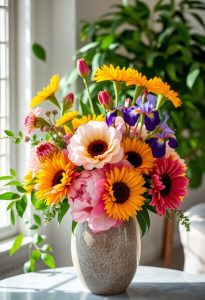If you want your garden to be bursting with color all season, search no further than Petunias, Marigolds, and Zinnias! These flowers thrive in sunny spots and, trust me, they’re like the overachievers of the floral world—always blooming and attracting butterflies and bees! Petunias are versatile, Marigolds repel pests, and Zinnias bring a fun flair. Just remember to deadhead for even more blooms! You’ll love how easy and rewarding these choices are. Ready to discover even more gardening gems?
Important Highlights
- Petunias continuously bloom in various colors, thriving in well-drained soil and sunlight with regular watering and deadheading.
- Marigolds offer bright seasonal blooms, repel pests, and are easy to grow in sunny spots with proper drainage.
- Geraniums require minimal maintenance while providing colorful blooms from spring to frost, benefiting from sunlight and deadheading.
- Zinnias are resilient, low-maintenance flowers that bloom vibrantly from summer to frost and attract butterflies.
- Lavender adds elegance and fragrance, blooms continuously, is drought-resistant, and attracts pollinators, enhancing garden aesthetics.
Petunias: The Versatile Bloomer
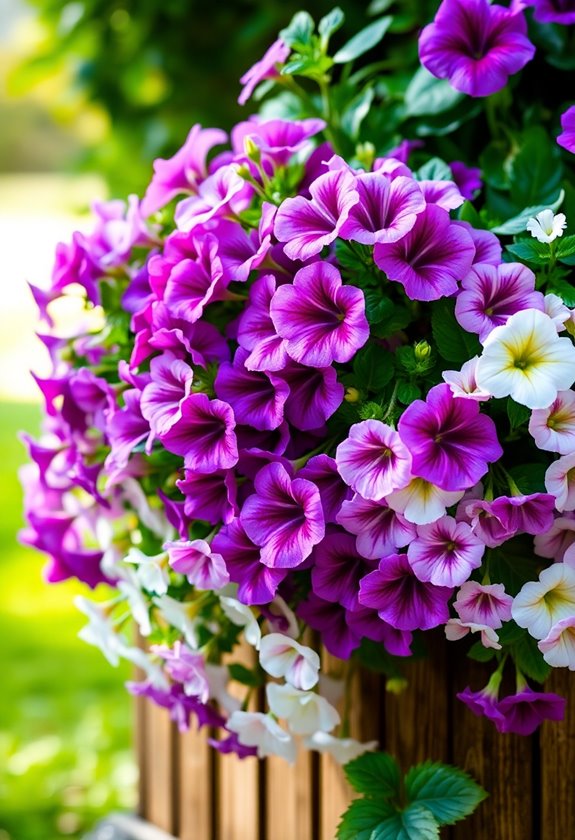
When you think about flowers that just keep on giving, petunias often come to mind! These beauties not only bloom continuously but also come in a rainbow of colors. Isn’t that fantastic? To guarantee they thrive, plant them in well-drained soil and give them plenty of sunlight. Water them regularly but avoid overwatering—nobody wants soggy roots!
Consider deadheading spent blooms to encourage even more flowers. Petunias are perfect for garden beds, pots, or hanging baskets. Additionally, they are well-suited for pot growth, making them a versatile choice for any space. So, why not try them out? You’ll be rewarded with vibrant colors all season long, bringing joy to your backyard oasis!
Marigolds: Bright and Cheerful
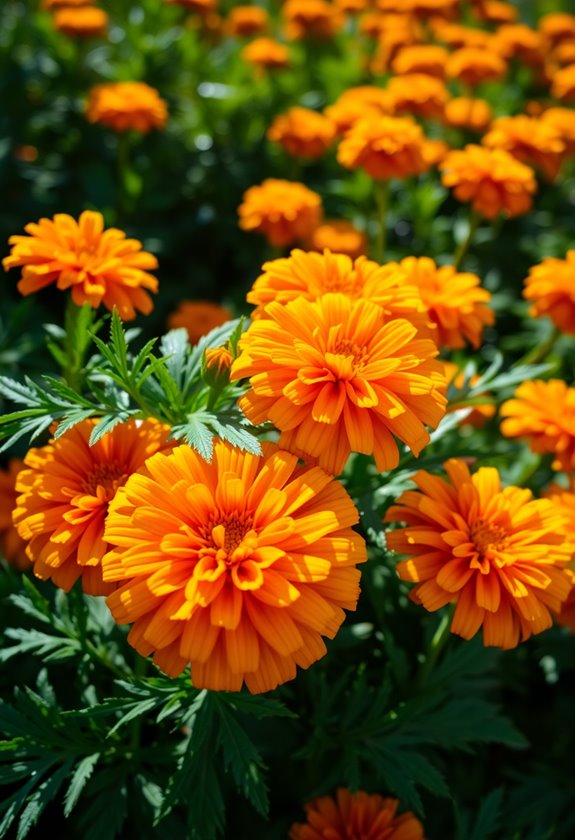
If you’re looking to add a splash of color to your garden, marigolds are the way to go! These vibrant flowers not only brighten your space but also repel pests—talk about a win-win! With their cheerful yellows and oranges, marigolds bloom all season long, making your garden feel alive. Plus, they’re super easy to grow! You can plant them in pots or along borders, and they thrive in sunny spots. Just make sure they’re watered regularly, and you’ll be rewarded with a dazzling display. Additionally, consider using containers with drainage holes to ensure optimal plant health. So, why not grab a pack of seeds? Your garden deserves that extra cheer! Are you ready?
Geraniums: Classic Garden Favorites

Although you might think of geraniums as just another pretty flower, these classic garden favorites bring so much more to the table! They’re low-maintenance, colorful, and resilient, making them perfect for your garden. Want blooms from spring to frost? Geraniums have your back! Just guarantee they get plenty of sunlight and well-drained soil.
Here are a few tips:
- Deadhead spent blooms to encourage new growth.
- Water them regularly but avoid soggy soil.
- Keep an eye out for pests—no one wants uninvited guests! Additionally, incorporating seasonal temperature extremes into your planting strategy can further enhance their resilience.
Zinnias: Vibrant and Resilient
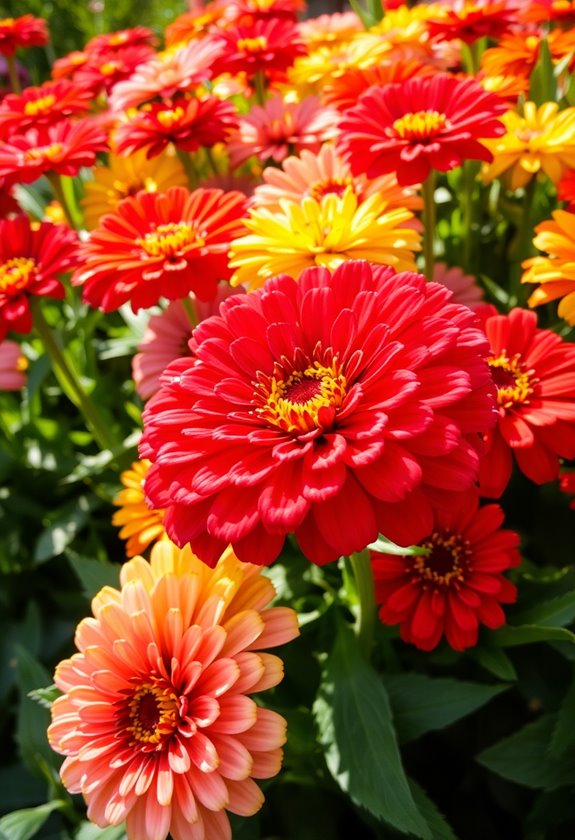
Zinnias are a fantastic choice for anyone looking to add a splash of color to their garden, especially since they thrive in sunny spots and bloom relentlessly from summer until the first frost! These vibrant flowers are super resilient, making them perfect for beginner gardeners like you. They come in various colors, so you can mix and match them for a stunning display. Just plant them in well-drained soil, water them regularly, and watch them flourish! Plus, they’re low-maintenance and attract butterflies—what’s not to love? So, why not brighten your garden with zinnias this season? You’ll be glad you did! Additionally, zinnias pair beautifully with diverse plant selection to create a visually interesting garden throughout the year.
Lavender: Fragrant and Functional
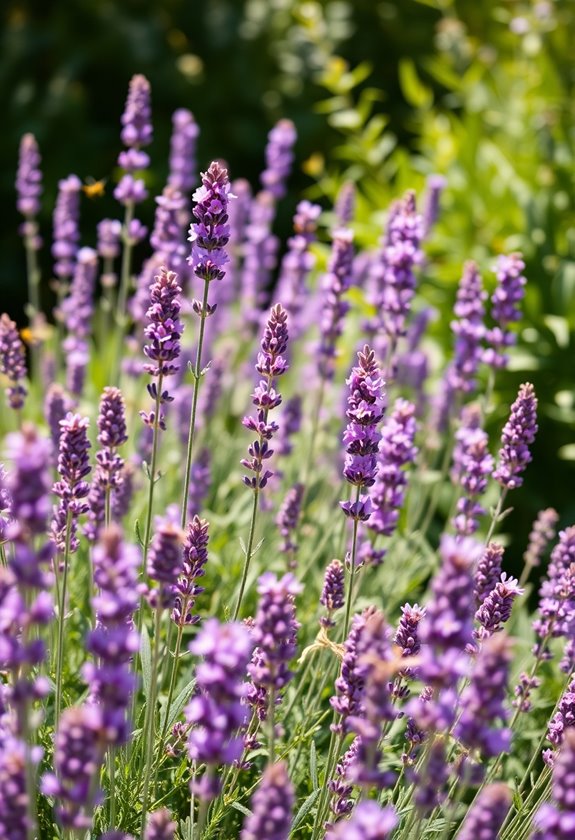
When you think of adding a touch of elegance and fragrance to your garden, lavender should be at the top of your list! Not only does it smell heavenly, but it’s also functional. You can use lavender in cooking, for relaxation, or even as a natural pest repellent. Plus, it’s drought-resistant, making it a smart choice for your garden. Additionally, incorporating lavender alongside vibrant garden decor can enhance your outdoor space’s aesthetic appeal.
| Feature | Benefits | Tips |
|---|---|---|
| Fragrance | Attracts pollinators | Plant in full sun |
| Culinary Uses | Flavor for dishes | Use fresh or dried |
| Pest Control | Repels insects | Combine with herbs |
Black-eyed Susans: Bold and Beautiful
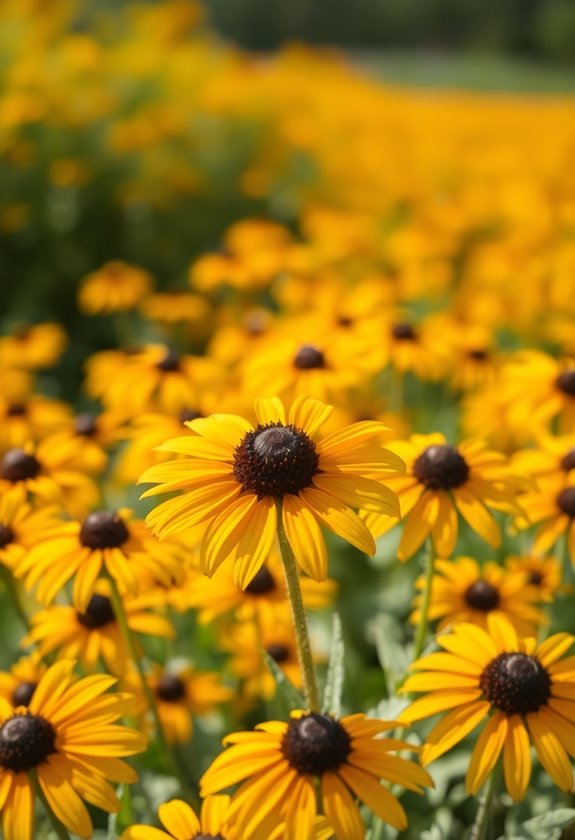
If you’re looking to add a splash of color to your garden, Black-eyed Susans are a fantastic choice! These cheerful blooms can brighten up any space, and they’re pretty low-maintenance. Plus, they thrive in various conditions! Here are four reasons to contemplate them:
- Long Blooming Season: They flower from summer to fall.
- Easy to Grow: Just plant them in well-drained soil.
- Drought-Resistant: Perfect for those dry spells!
- Wildlife Friendly: Attracts butterflies and birds.
With their bold yellow petals and dark centers, you’ll find yourself smiling every time you step outside. Happy gardening!
Salvia: Attractive to Pollinators

Not only do Salvia plants boast stunning spikes of vibrant color, but they also play an essential role in attracting pollinators to your garden! Have you ever watched bees and butterflies flitting around these beauties? It’s mesmerizing! Their nectar-rich flowers are like a buffet for these important creatures. To create a pollinator-friendly space, plant Salvia in clusters, allowing them to thrive together. You’ll not only enhance your garden’s beauty but also support local ecosystems. Plus, their drought resistance means less watering for you—talk about a win-win! So, why not invite these lovely visitors to your backyard? You won’t regret it!
Coreopsis: Low Maintenance and Colorful
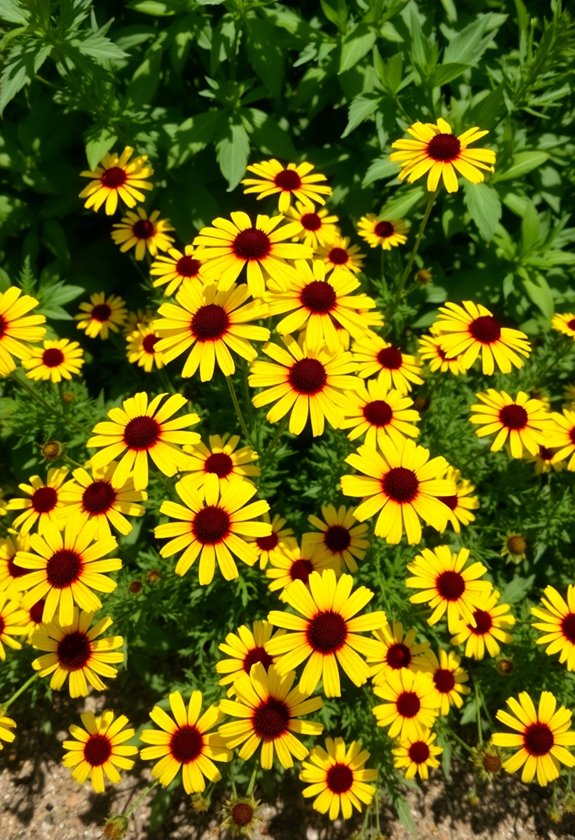
Imagine stepping into your garden and being greeted by a burst of sunny yellow blooms that seem to dance in the breeze; that’s the magic of Coreopsis! These low-maintenance beauties bring vibrant color without the fuss. If you want to add them to your garden, here’s why they’re a fantastic choice:
- Thrive in various soil types
- Attract butterflies, enhancing your garden’s life
- Require minimal watering once established
- Bloom from spring to fall, keeping your garden lively
Begonias: Shade-Loving Beauties
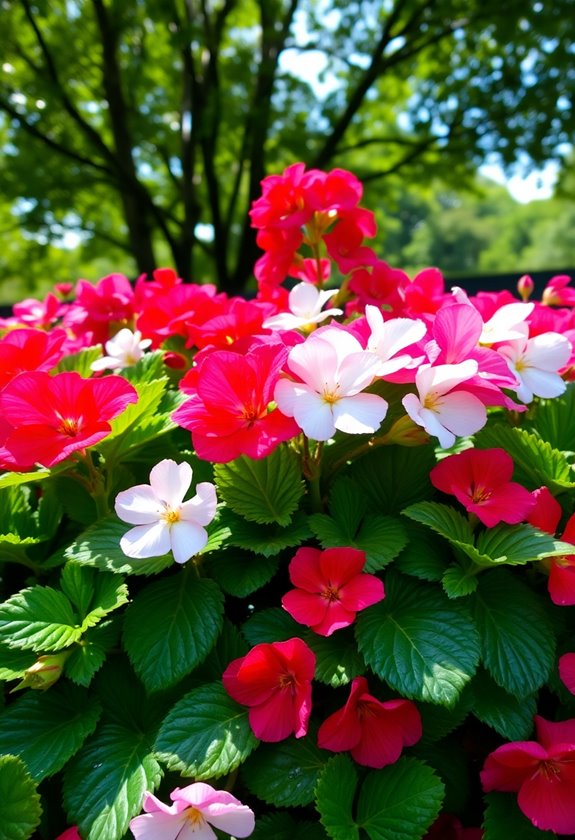
While many flowers crave full sunlight, begonias thrive in the shade, making them a perfect choice for those tricky spots in your garden where sunlight just doesn’t reach. These vibrant blooms come in various colors, from bold reds to soft pastels, adding charm to any corner. They’re low-maintenance too! Just make sure they get well-drained soil and a bit of water.
Have you ever tried mixing them with ferns? It creates a stunning contrast! Plus, they’re safe for pets and kids. So, why not brighten your shady areas with these beauties? You’ll love the continuous color they bring all season long!
Frequently Asked Questions
How Do I Care for Flowers to Ensure Continuous Blooming?
Caring for flowers is like nurturing a friendship—you’ve gotta put in effort! To keep them blooming, water them regularly, but don’t drown them—too much can cause root rot. Prune spent blooms to encourage new growth, and feed them with a balanced fertilizer every few weeks. Have you tried mulching? It helps retain moisture and keeps weeds away. And remember, a little sunshine goes a long way! Happy gardening! 🌼
What Are the Best Soil Types for These Blooming Flowers?
When it comes to soil for your blooming flowers, you’ll want to focus on well-draining, nutrient-rich types. Think about adding compost or peat moss to improve texture and nutrients. A pH level between 6.0 and 7.0 works best for most flowers. Have you ever noticed how some plants thrive in sandy soil while others prefer clay? It’s all about finding the right match! Don’t worry; experimenting can be fun! Happy gardening!
Can These Flowers Survive in Extreme Weather Conditions?
Did you know that some flowers can actually endure temperatures as low as -40°F? When you’re choosing flowers for extreme weather, look for hardy varieties like pansies or sedums. They’ve got resilience! Just make sure to plant them in well-drained soil and provide some shelter from harsh winds. Have you thought about mulching? It helps protect roots during temperature swings. Remember, your garden should thrive no matter what Mother Nature throws at it!
How Often Should I Fertilize Blooming Flowers During the Season?
You should fertilize your blooming flowers every four to six weeks during the growing season. This keeps them energized and thriving! Just use a balanced, slow-release fertilizer for the best results. Have you ever seen a flower wilt? It’s no fun! If you notice yellowing leaves or stunted growth, it’s time to give them a boost. Happy gardening! Remember, a little love goes a long way in your backyard paradise!
When Is the Best Time to Plant These Flowers for Optimal Growth?
When’s the best time to plant your flowers? Ideally, you want to get those seeds or seedlings in the ground after the last frost, usually in spring! If you’re in a warmer area, mid to late spring is perfect. Remember, the soil should be warm and workable. Have you ever felt the excitement of watching them sprout? It’s like magic! Just imagine all the colors blooming in your garden. Isn’t that thrilling?


